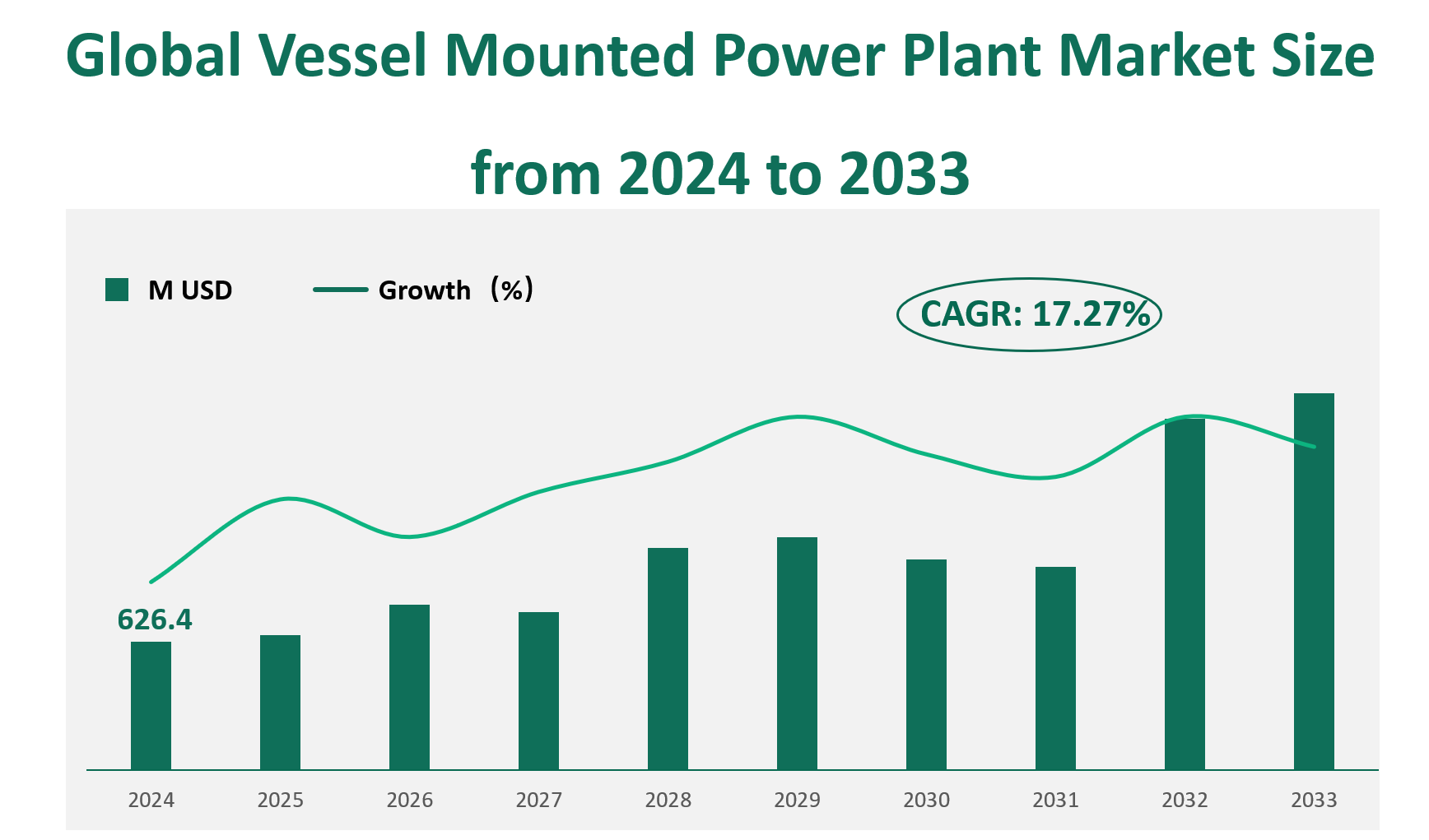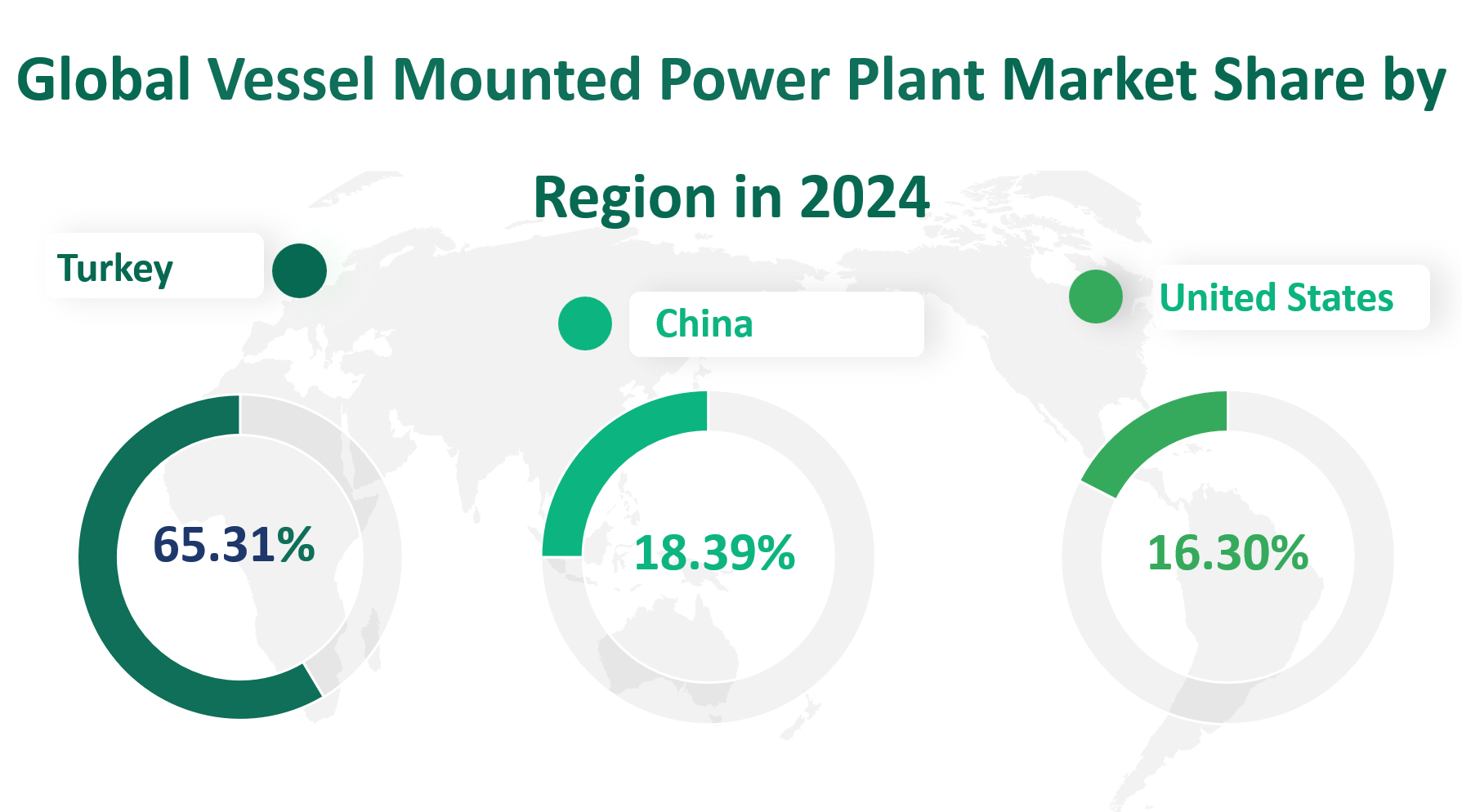1. Global Vessel Mounted Power Plant Market Insight Analysis
In 2024, the global Vessel Mounted Power Plant market is projected to reach a revenue of $626.4 million USD, with a Compound Annual Growth Rate (CAGR) of 17.27% from 2024 to 2033.
A Vessel Mounted Power Plant, also known as a floating power plant, is a unique energy solution designed to provide electricity and heat to remote or hard-to-reach areas. These power plants are essentially mobile platforms equipped with one or more nuclear reactors or other power generation systems, such as diesel engines or gas turbines. They are typically stationed offshore or near coastal regions and can be connected to the mainland’s power grid to supply electricity.
The concept of Vessel Mounted Power Plants emerged as a response to the challenges faced by traditional land-based power plants, particularly in regions with limited infrastructure or where land availability is a constraint. These floating power plants offer several advantages, including flexibility in location, ease of deployment, and the ability to quickly respond to changing energy demands. They are particularly useful in areas with unstable power grids, high energy demands, or where rapid electrification is required.
One of the most notable examples of a Vessel Mounted Power Plant is the Khan Class Powerships developed by Karpowership. These ships are capable of generating up to 470 MW of power and are designed to be highly efficient and environmentally friendly. They can operate on multiple fuels, including heavy fuel oil and liquefied natural gas (LNG), making them versatile solutions for various regions.
Figure Global Vessel Mounted Power Plant Market Size (M USD) and CAGR (2024-2033)

2. Driving and Limiting Factors of Vessel Mounted Power Plant Market Growth
The growth of the Vessel Mounted Power Plant market is driven by several key factors. Firstly, the increasing global demand for energy, particularly in developing countries, is a major driver. As economies expand and populations grow, the need for reliable and flexible power solutions becomes more critical. Vessel Mounted Power Plants offer a quick and efficient way to meet these demands, especially in regions with limited infrastructure.
Another significant driver is the growth in natural gas production. Natural gas is a cleaner and more efficient fuel compared to traditional fossil fuels, making it an attractive option for power generation. The ability of Vessel Mounted Power Plants to utilize natural gas, either directly or through LNG, enhances their appeal in markets with abundant natural gas resources.
Infrastructure development in the Asia-Pacific region is also a major factor. Countries like China and India are experiencing rapid economic growth, leading to increased demand for electricity. Vessel Mounted Power Plants can provide a temporary or permanent solution to meet this demand, especially in coastal areas where land-based power plants may not be feasible.
One of the most significant is the high maintenance cost associated with these plants. Due to their offshore location and exposure to harsh environmental conditions, they require regular maintenance, which can be costly and time-consuming. Additionally, accessing these plants for maintenance, especially during adverse weather conditions, can be challenging.
3. Technology Innovation and Corporate Mergers and Acquisitions in Vessel Mounted Power Plant Market
The Vessel Mounted Power Plant market is witnessing significant technological innovation. Companies are constantly working to improve the efficiency and environmental performance of their floating power plants. For instance, Karpowership’s Khan Class Powerships are designed to be highly efficient and capable of operating on multiple fuels. This flexibility allows them to adapt to different market conditions and fuel availability.
Corporate mergers and acquisitions are also shaping the market. Companies are looking to expand their portfolios and enhance their technological capabilities through strategic partnerships and acquisitions. For example, Kawasaki Heavy Industries has been awarded an Approval in Principle (AIP) for their LNG floating power plant concept by DNV GL. This recognition highlights the company’s commitment to innovation and its ability to develop advanced solutions for the market.
4. Global Vessel Mounted Power Plant Market Size by Type
Vessel Mounted Power Plants can be categorized into two primary types: Diesel Power and Gas Turbine Power.
Diesel Power Vessel Mounted Power Plants are designed to utilize diesel fuel to generate electricity. These power plants are known for their reliability and efficiency in converting diesel into electrical energy. Diesel engines are widely used due to their robustness and ability to operate in various environmental conditions. In 2024, the market revenue for Diesel Power Vessel Mounted Power Plants is projected to be $96.5 million.
Gas Turbine Power Vessel Mounted Power Plants utilize natural gas as their primary fuel source. These power plants are known for their high efficiency and lower emissions compared to diesel engines. Gas turbines can achieve higher power outputs and are often preferred for larger-scale power generation. In 2024, the market revenue for Gas Turbine Power Vessel Mounted Power Plants is projected to be $529.9 million.
Table Global Vessel Mounted Power Plant Market Size by Type in 2024
5. Global Vessel Mounted Power Plant Market Size by Application
The applications of Vessel Mounted Power Plants are diverse, catering to various power needs across different regions and industries. The primary applications include Low-power FPP (Floating Power Plants), Medium-power FPP, and High-power FPP.
Medium-power Floating Power Plants cater to areas with moderate power needs, typically ranging from 10 MW to 50 MW. These power plants are used in small to medium-sized cities or industrial zones. In 2024, the market revenue for Medium-power FPP is projected to be $155.5 million. Medium-power FPPs play a crucial role in providing reliable power to regions where the existing grid infrastructure is insufficient or unreliable.
High-power Floating Power Plants are designed to meet the electricity needs of large cities, industrial hubs, and regions with significant power demands. These power plants have a capacity of over 50 MW and are often used to supplement existing power grids or provide power to off-grid areas. In 2024, the market revenue for High-power FPP is projected to be $470.9 million. High-power FPPs are the most dominant application segment, driven by the increasing demand for large-scale power generation and the need to support growing urban and industrial areas.
Table Global Vessel Mounted Power Plant Market Size by Application in 2024
Application | Market Size (M USD) 2024 |
Medium-power FPP | 155.5 |
High-power FPP | 470.9 |
6. Global Vessel Mounted Power Plant Market by Top Regions
The United States is a key market for Vessel Mounted Power Plants, driven by its extensive coastline and significant energy demands. In 2024, the market revenue for Vessel Mounted Power Plants in the United States is projected to be $102.1 million. The growth in this region is primarily driven by the need for reliable power solutions in coastal areas, especially in response to natural disasters and grid failures.
China is emerging as a fast-growing market for Vessel Mounted Power Plants, with a projected market revenue of $115.2 million in 2024. The rapid industrialization and urbanization in China have led to significant increases in energy demand, particularly in coastal regions.
Turkey has historically been a dominant player in the Vessel Mounted Power Plant market and continues to be a significant market in 2024, with a projected revenue of $409.1 million. Turkey’s strategic location and extensive coastline make it a key market for floating power plants.
Figure Global Vessel Mounted Power Plant Market Size by Region in 2024

7. Global Vessel Mounted Power Plant Market Analysis by Major Players
7.1 Karpowership
Company Introduction and Business Overview: Karpowership is a leading provider of floating power plant solutions, known for its innovative and reliable power generation services. Established in 1948, the company operates globally, with a strong presence in Africa, America, Asia, Europe, and the Middle East. Karpowership is renowned for its Powership fleet, which offers flexible and efficient power solutions to various regions.
Products Offered: Karpowership offers a range of floating power plants, including the Khan Class Powerships, which have a capacity of 415-470 MW. These ships are designed to provide significant power outputs while maintaining high efficiency and low environmental impact. Karpowership’s power plants are equipped with advanced technologies to ensure reliable and sustainable power generation.
7.2 Power Barge Corporation
Company Introduction and Business Overview: Power Barge Corporation is a private company established in 2000, specializing in turnkey projects, procurement, and construction contracting for barge power plants. The company offers comprehensive after-sales and consulting services to developers, owners, and operators of barge power plants equipped with gas turbines, medium-speed engines, and energy storage systems.
Products Offered: Power Barge Corporation provides a variety of barge power plants, including medium-speed engine-powered barges with capacities ranging from 80 MW to 200 MW. These barges are designed to operate on natural gas, diesel, biodiesel, and low-sulfur heavy fuel oil, offering flexibility and efficiency in power generation.
7.3 Kawasaki Heavy Industries
Company Introduction and Business Overview: Kawasaki Heavy Industries, established in 1896, is a global leader in the design, development, and manufacturing of transport equipment and industrial heavy machinery. The company offers a wide range of products, including ships, railroad cars, aircraft engines, hydraulic and gas turbines, and industrial robots. Kawasaki Heavy Industries is known for its engineering and construction services to industrial plants.
Products Offered: Kawasaki Heavy Industries offers LNG Floating Power Plants, which feature high-efficiency gas engines and turbines. These power plants are designed to provide reliable and sustainable power solutions with low environmental impact. The company’s advanced manufacturing capabilities ensure high-quality and reliable delivery of its products.

